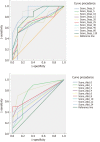Nutrient drink test: A promising new tool for irritable bowel syndrome diagnosis
- PMID: 30809083
- PMCID: PMC6385016
- DOI: 10.3748/wjg.v25.i7.837
Nutrient drink test: A promising new tool for irritable bowel syndrome diagnosis
Abstract
Background: Irritable bowel syndrome (IBS) is a highly prevalent condition. It is diagnosed on the basis of chronic symptoms after the clinical and/or investigative exclusion of organic diseases that can cause similar symptoms. There is no reproducible non-invasive test for the diagnosis of IBS, and this raises diagnostic uncertainty among physicians and hinders acceptance of the diagnosis by patients. Functional gastrointestinal (GI) syndromes often present with overlapping upper and lower GI tract symptoms, now believed to be generated by visceral hypersensitivity. This study examines the possibility that, in IBS, a nutrient drink test (NDT) provokes GI symptoms that allow a positive differentiation of these patients from healthy subjects.
Aim: To evaluate the NDT for the diagnosis of IBS.
Methods: This prospective case-control study compared the effect of two different nutrient drinks on GI symptoms in 10 IBS patients (patients) and 10 healthy controls (controls). The 500 kcal high nutrient drink and the low nutrient 250 kcal drink were given in randomized order on separate days. Symptoms were assessed just before and at several time points after drink ingestion. Global dyspepsia and abdominal scores were derived from individual symptom data recorded by two questionnaires designed by our group, the upper and the general GI symptom questionnaires, respectively. Psycho-social morbidity and quality of life were also formally assessed. The scores of patients and controls were compared using single factor analysis of variance test.
Results: At baseline, IBS patients compared to controls had significantly higher levels of GI symptoms such as gastro-esophageal reflux (P = 0.05), abdominal pain (P = 0.001), dyspepsia (P = 0.001), diarrhea (P = 0.001), and constipation (P = 0.001) as well as higher psycho-social morbidity and lower quality of life. The very low incidence of GI symptoms reported by control subjects did not differ significantly for the two test drinks. Compared with the low nutrient drink, IBS patients with the high nutrient drink had significantly more dyspeptic symptoms at 30 (P = 0.014), 45 (P = 0.002), 60 (P = 0.001), and 120 min (P = 0.011). Dyspeptic symptoms triggered by the high nutrient drink during the first 120 min gave the best differentiation between healthy controls and patients (area under receiver operating curve of 0.915 at 45 min for the dyspepsia score). Continued symptom monitoring for 24 h did not enhance separation of patients from controls.
Conclusion: A high NDT merits further evaluation as a diagnostic tool for IBS.
Keywords: Dyspepsia; Irritable bowel syndrome; Non-invasive; Nutrient drink test; Screening.
Conflict of interest statement
Conflict-of-interest statement: None of the authors have conflicts of interest to be declared.
Figures




Similar articles
-
Overlapping upper and lower gastrointestinal symptoms in irritable bowel syndrome patients with constipation or diarrhea.Am J Gastroenterol. 2003 Nov;98(11):2454-9. doi: 10.1111/j.1572-0241.2003.07699.x. Am J Gastroenterol. 2003. PMID: 14638348
-
Functional Dyspepsia and Severity of Psychologic Symptoms Associate With Postprandial Symptoms in Patients With Irritable Bowel Syndrome.Clin Gastroenterol Hepatol. 2018 Nov;16(11):1745-1753.e1. doi: 10.1016/j.cgh.2018.04.034. Epub 2018 Apr 24. Clin Gastroenterol Hepatol. 2018. PMID: 29702295
-
A combined nutrient and lactulose challenge test allows symptom-based clustering of patients with irritable bowel syndrome.Am J Gastroenterol. 2013 May;108(5):786-95. doi: 10.1038/ajg.2013.75. Epub 2013 Apr 16. Am J Gastroenterol. 2013. PMID: 23588235 Clinical Trial.
-
Overlapping abdominal symptoms: why do GERD and IBS often coexist?Drugs Today (Barc). 2006 Jul;42 Suppl B:3-8. Drugs Today (Barc). 2006. PMID: 16986065 Review.
-
Diagnosis and Treatment of Irritable Bowel Syndrome: A Review.JAMA. 2021 Mar 2;325(9):865-877. doi: 10.1001/jama.2020.22532. JAMA. 2021. PMID: 33651094 Review.
References
-
- Lovell RM, Ford AC. Global prevalence of and risk factors for irritable bowel syndrome: A meta-analysis. Clin Gastroenterol Hepatol. 2012;10:712–721.e4. - PubMed
-
- Ford AC, Talley NJ, Walker MM, Jones MP. Increased prevalence of autoimmune diseases in functional gastrointestinal disorders: Case-control study of 23471 primary care patients. Aliment Pharmacol Ther. 2014;40:827–834. - PubMed
-
- Badia X, Mearin F, Balboa A, Baró E, Caldwell E, Cucala M, Díaz-Rubio M, Fueyo A, Ponce J, Roset M, Talley NJ. Burden of illness in irritable bowel syndrome comparing Rome I and Rome II criteria. Pharmacoeconomics. 2002;20:749–758. - PubMed
-
- Mearin F, Lacy BE, Chang L, Chey WD, Lembo AJ, Simren M, Spiller R. Bowel Disorders. Gastroenterology. 2016;pii:S0016–5085(16)00222-5. - PubMed
-
- Ford AC, Bercik P, Morgan DG, Bolino C, Pintos-Sanchez MI, Moayyedi P. Validation of the Rome III criteria for the diagnosis of irritable bowel syndrome in secondary care. Gastroenterology. 2013;145:1262–70.e1. - PubMed
Publication types
MeSH terms
Substances
LinkOut - more resources
Full Text Sources
Medical

